





Blog
Klaviyo Segmentation

Blog
Klaviyo Segmentation

Blog
Klaviyo Segmentation

Blog
Klaviyo Segmentation
Why Smarter Digital Relationships Begin with Segmentation
Why Smarter Digital Relationships Begin with Segmentation
Why Smarter Digital Relationships Begin with Segmentation
Why Smarter Digital Relationships Begin with Segmentation

Shubhangi Kaushik
Apr 15, 2024

Shubhangi Kaushik
Apr 15, 2024

Shubhangi Kaushik
Apr 15, 2024

Shubhangi Kaushik
Apr 15, 2024
Table of Content
>
Title
>
Title
>
Title
>
Title
Here’s the truth about email marketing in 2024.
The days of sending out one-size-fits-all emails are gone. No matter how flashy your email is or how awesome your copy is, the email isn’t going to cut through the cluttered inbox anymore.
So what’s the secret of getting higher engagement and conversions with email marketing?
The answer is - Segmentation.
In this comprehensive guide, you'll embark on a journey to unlock the secrets of effective email segmentation.
So, let's jump in.
What is Email Segmentation?
Email segmentation is the art of organizing your email subscriber list into smaller, more targeted groups. You can implement segmentation based on various characteristics, behaviors, and preferences.
Instead of sending the same boring message to your entire list, segmentation allows you to tailor your content for micro-audiences.
Why is Email Segmentation so Powerful?
Segmentation allows you to cut through the noise and provide your subscribers with content that is truly relevant and valuable to them.
Let's understand how-
When you implement effective email segmentation, you'll experience a myriad of benefits, including:
1. Increased Open and Click-Through Rates
HubSpot says segmented emails get way more attention than unsegmented ones. You can expect 50% more clickthrough and 30% more open rate in segmented emails.
2. Enhanced Conversion Rates
It is no secret that targeted, personalized messages deeply resonate with your audience. This leads to a significant improvement in engagement and conversions.
3. Improved Customer Retention and Loyalty
With personalized content to segmented audiences, you'll foster stronger relationships which in turn will positively impact customer loyalty.
4. Keeps Your List Healthy
Segmentation reduces the probability of unsubscribes and spam complaints thereby keeping your list healthy.
5. Deeper Insights and Data-Driven Decisions:
Data from segmented campaigns provide invaluable insights allowing you to make more informed, data-driven decisions.
Now that we are clear about the importance of email segmentation, let us dive right into implementation.
How to Incorporate Segmentation in Your Email Marketing
1. Data Collection and Analysis
Segmentation begins with collecting first-party and zero-party customer data and organizing it.
Zero-party data refers to information that your customers willingly and explicitly provide. Such as preferences, interests, and demographic details. This data is incredibly valuable, as it reflects your audience's direct input and intentions.
First-party data, on the other hand, is the information you gather about your subscribers' behaviors and interactions with your brand. This includes website activity, purchase history, and email engagement.
You can combine these two data sources to paint a detailed portrait of your audience. In turn, you can create highly targeted segments that resonate with their unique needs and desires.
2. Segment Definition and Criteria
With a wealth of data at your fingertips, it's time to put it to work by defining your segmentation criteria. This step involves identifying the characteristics, behaviors, and preferences that will serve as the foundation for your targeted email campaigns.
For instance, a buyer has a 27% likelihood of coming back to your shop after making one transaction. You can make this happen if you send a perfectly tailored email segmented for this category.
Some common segmentation criteria to consider include:
- Demographic factors (age, gender, location, etc.)
- Psychographic traits (interests, values, lifestyle)
- Behavioral patterns (website activity, purchase history, email engagement)
- Lifecycle stage (new subscribers, active customers, inactive users)
- Purchase intent and readiness (cart abandoners, product browsing behavior)
- Loyalty and engagement levels (VIPs, frequent buyers, disengaged subscribers)
So, define your segmentation criteria to ensure that each of your email campaigns speaks directly to your target audience.
3. Personalized Content Creation
With your segmented lists in place, it's time to put the power of personalization to work. Craft targeted email content that resonates with each of your distinct subscriber groups. Thus, addressing their pain points, interests, and preferences.
Transaction rates are six times greater when you send personalized emails. Even 90% of marketers say personalization is important.
This level of personalization might include:
- Tailored subject lines and email copy
- Hyper-relevant product recommendations
- Segment-specific offers, discounts, and incentives
- Customized visuals and design elements
- Curated content based on subscribers' interests
Remember, the goal is to make your subscribers feel seen, heard, and valued. This way you'll foster deeper connections, increase engagement, and drive meaningful conversions.
A Few Segmentation Tactics to Consider
Email list segmentation boosts email marketing income by 760% for you. So, let's understand how you can shine in the inbox of your customers.
Combination Segments
Combine multiple segmentation criteria to create highly targeted micro-segments. For example- you could segment by both location and purchase history. This way can deliver unique offers to high-value customers in specific regions.
For example- Nanit sends this email to US people on the 4th of July. They combine location and timing segmentation to create an impact on their customers.
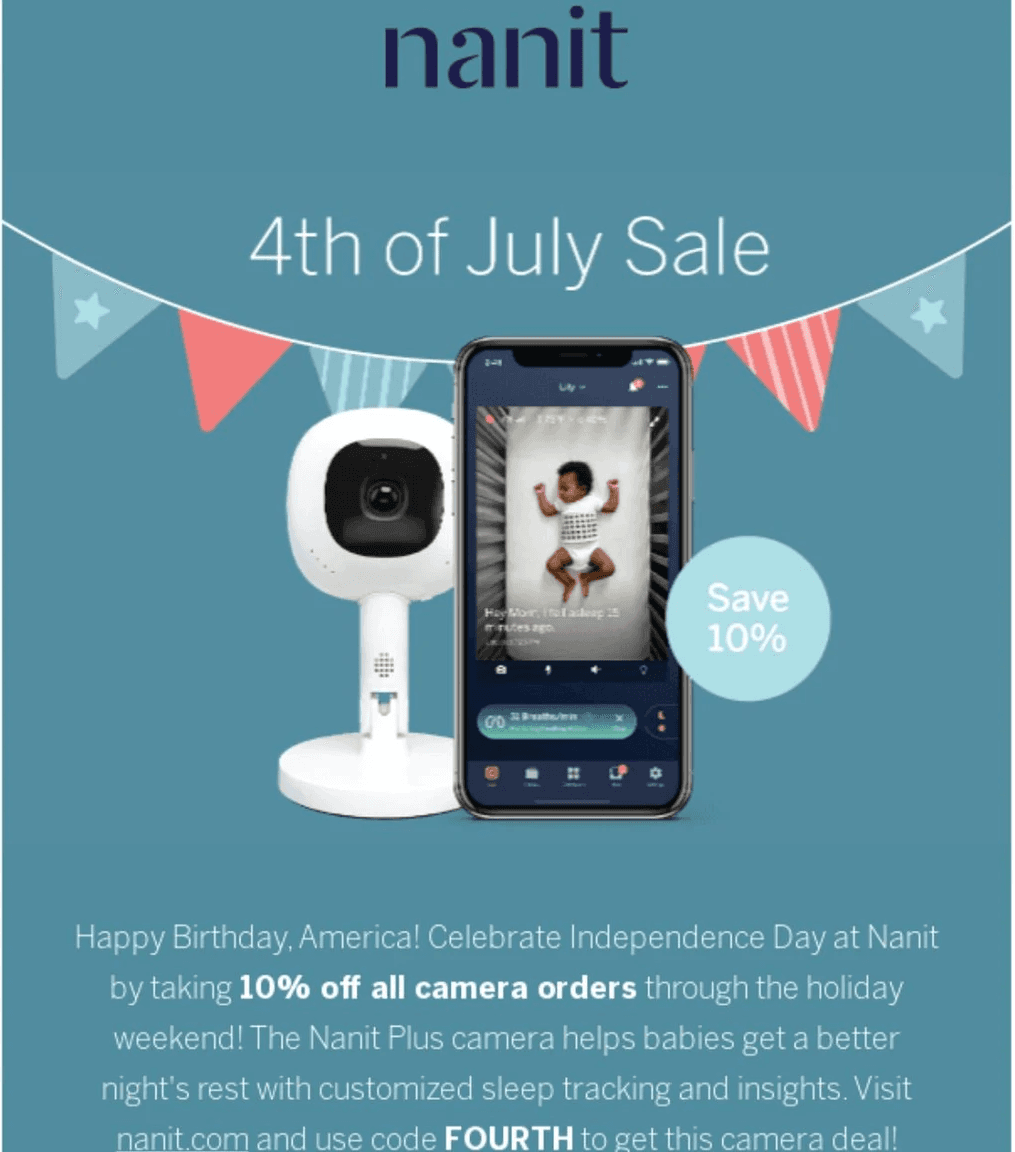
Predictive Segments
Use machine learning and predictive analytics to anticipate your subscribers' behaviors and preferences. This could involve segmenting based on predicted lifetime value, churn risk, or product affinities.
For example- Duolingo sends emails when they analyze that customers are not attending classes and could leave.

Triggered Segments
Leverage real-time data and automation to create dynamic, event-driven segments. You could trigger a tailored campaign for subscribers who abandon their carts. Else you can be more specific like for those who browse specific product categories.
For example- This email by Fabletics men about an abandoned cart.
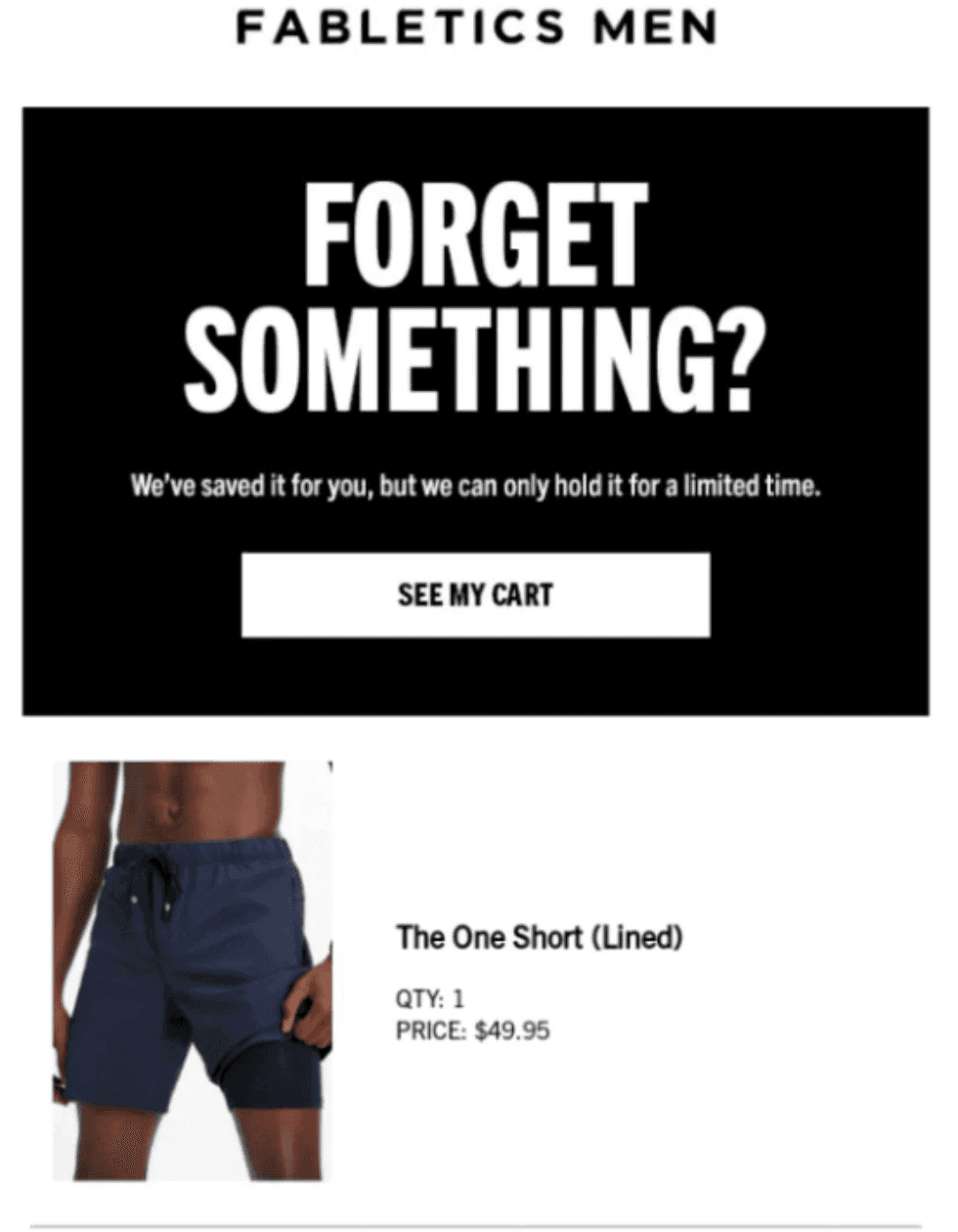
Persona-Based Segments
Develop detailed buyer personas to guide your segmentation efforts. Group your subscribers according to their unique pain points, motivations, and shopping habits. Then craft content that resonates with each persona.
For Example- Rael does it by constantly reviewing when customers check their products. Sending them emails to remind the same products.
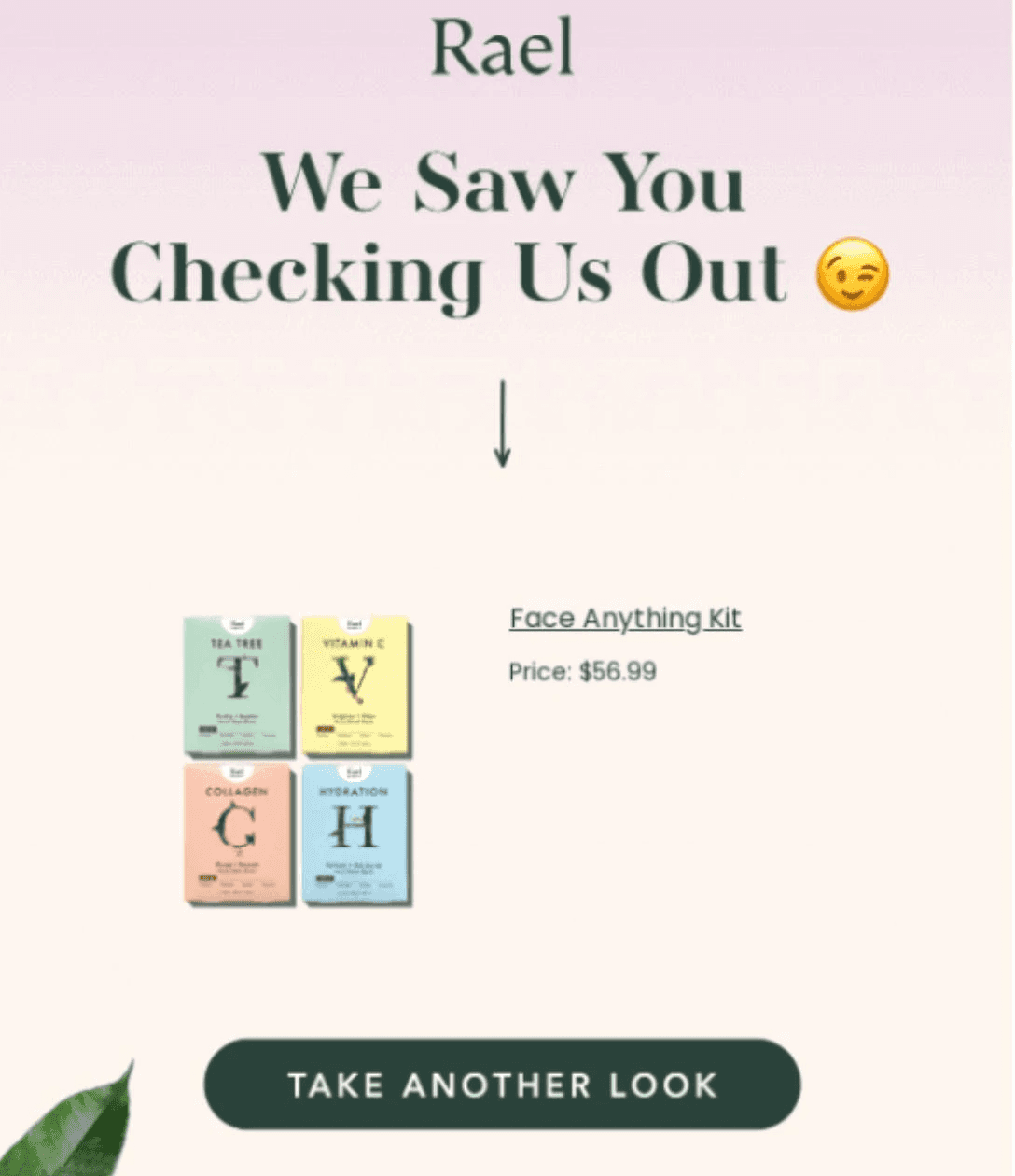
You can use tools like Klaviyo to incorporate advanced tactics. They can work wonders for your business when used strategically.
Behavior-based Segments
This segment groups email recipients based on their actions or interactions with your brand. You can segment customers by the products they've purchased or pages they visited.
Audible sends this email to the customer, stating that their wish list is now available.
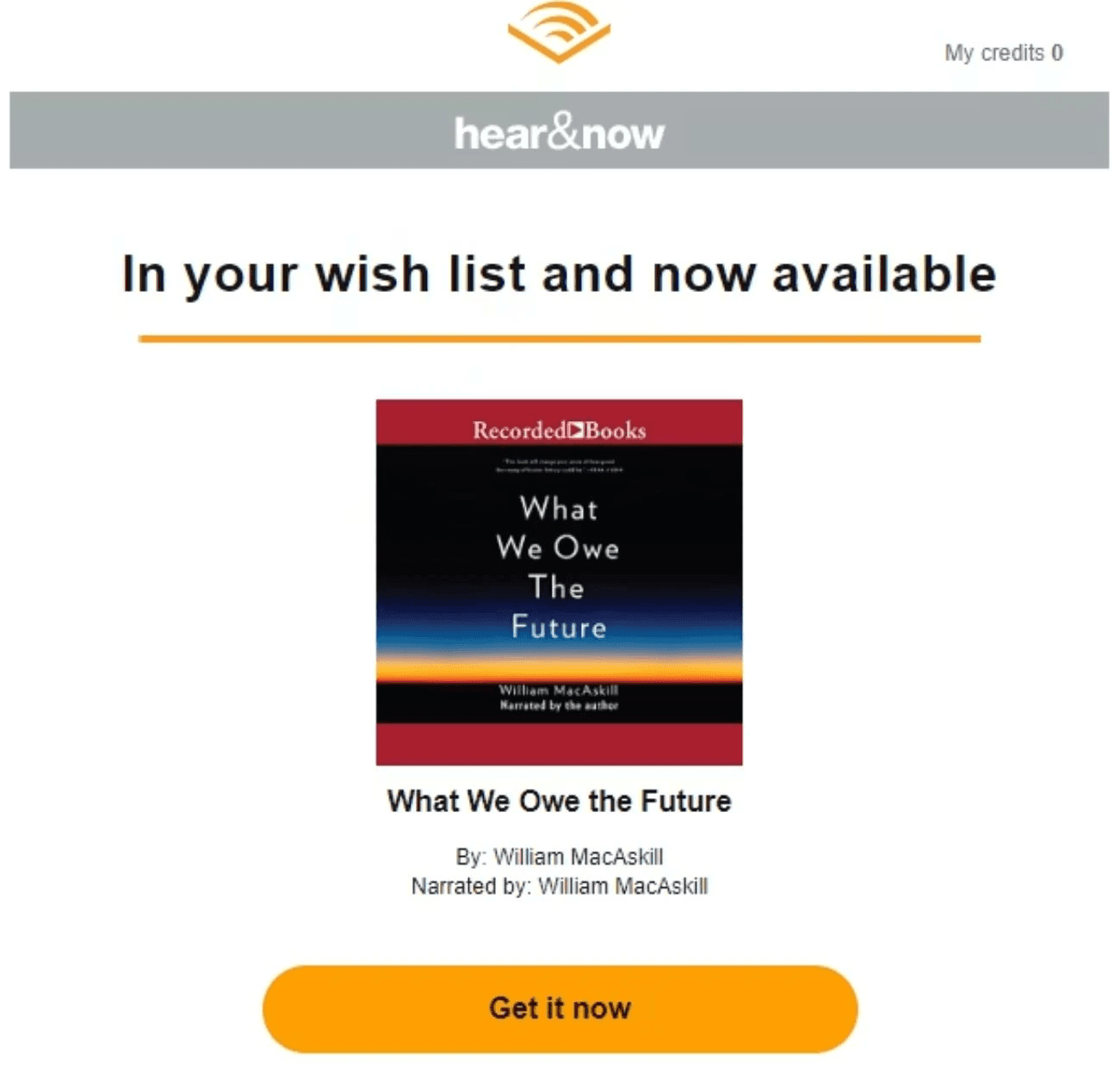
Demographic Segments
Demographic segment groups such as age, income location, etc. This segment gathers all the demographic information of its users and craft emails accordingly.
For Example- You can see Groupon uses location details to send this email to customers based in California.

Life cycle Segments
This is one of the most crucial segments. Here, you can group the customers on their stage in the customer journey. It includes new subscribers, active customers, and, lapsing ones.
Squarespace sends this kind of email to new customers.
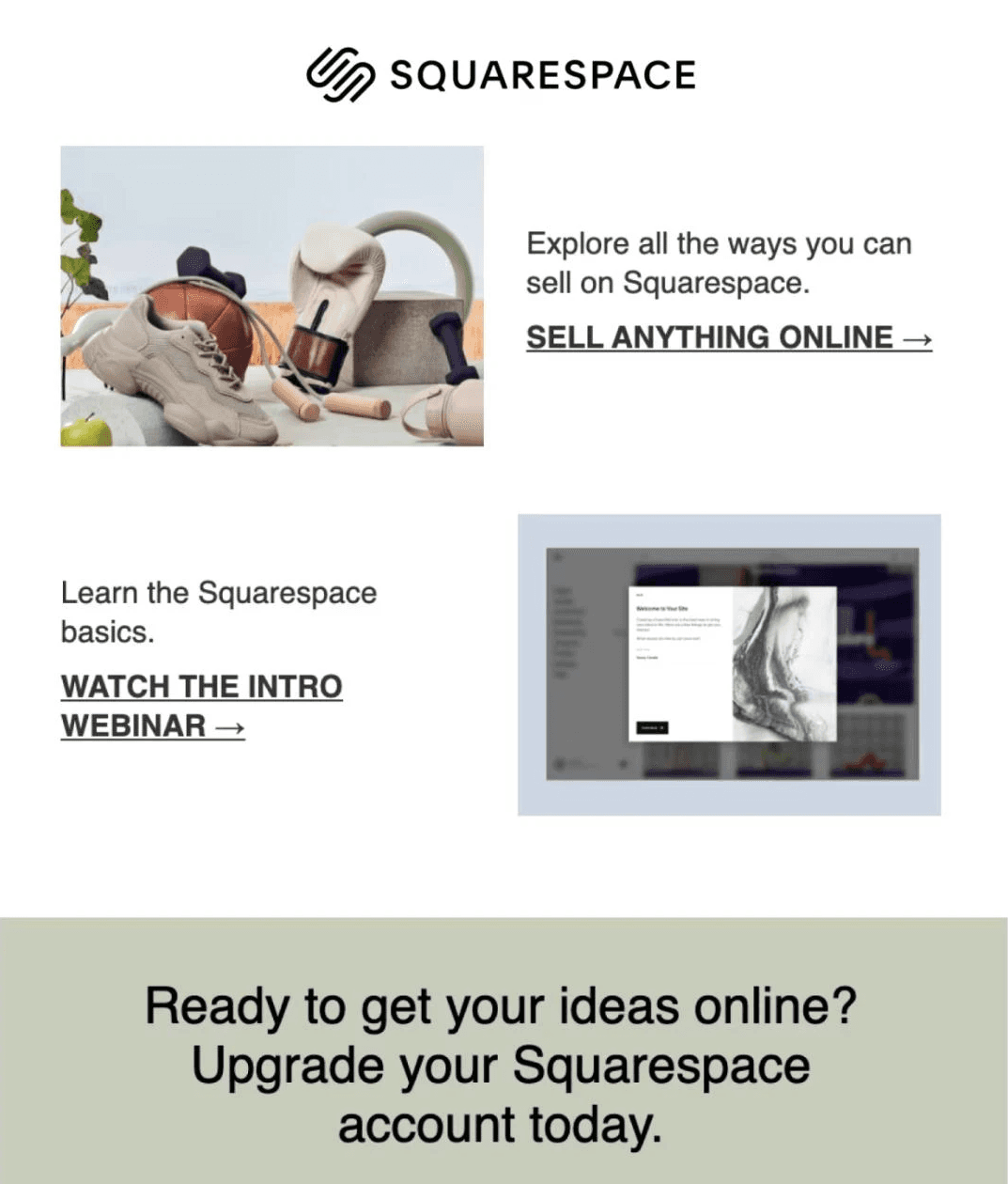
Gender-based Segments
This segment groups recipients based on their gender. While personalization is key, avoid stereotypes here. Focus on product offerings or content that might be relevant to different genders.
Here are two different emails from prom.ua. This one is for women’s shoes.
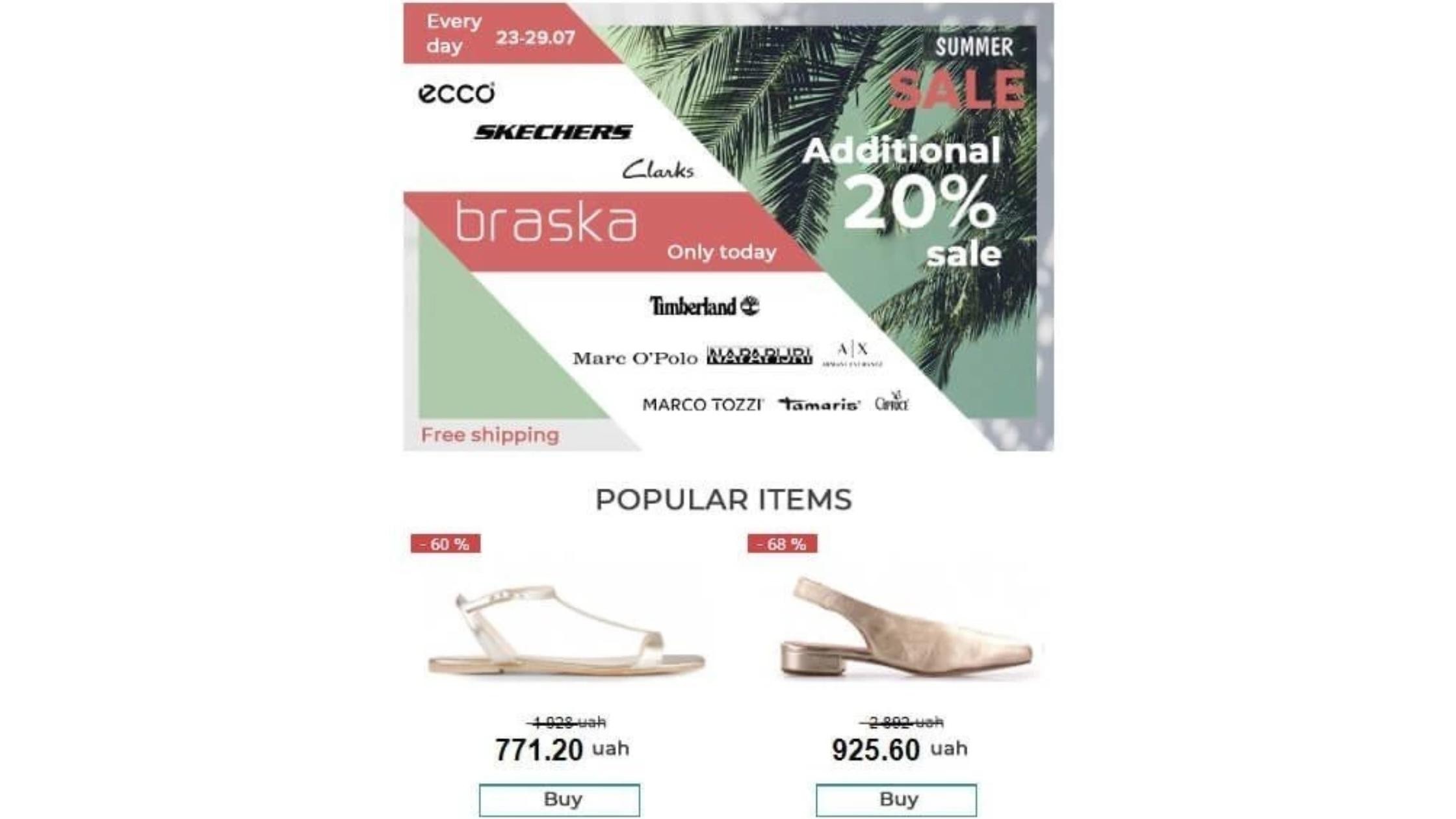
This one is for men’s shoes.
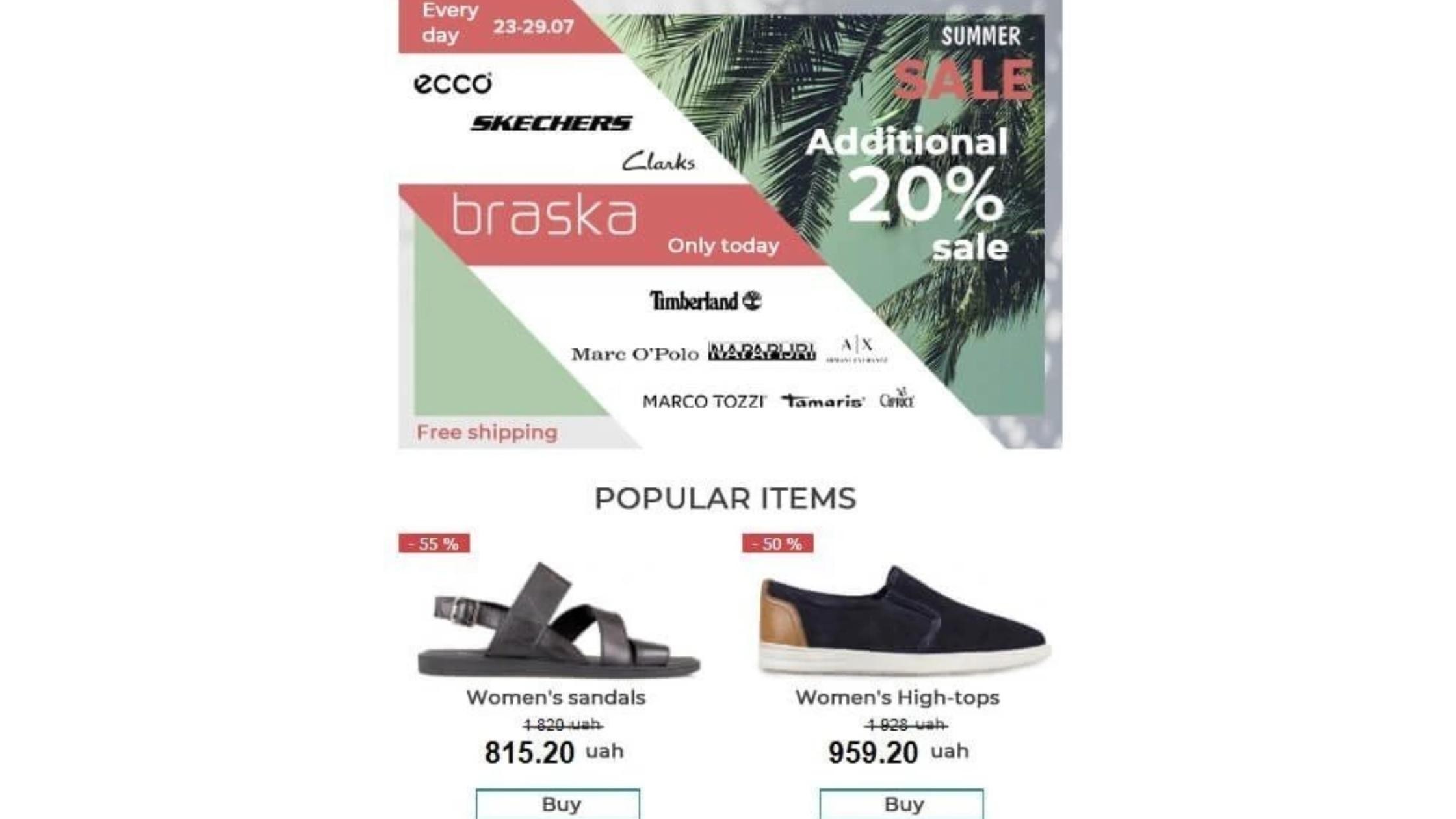
Customer Activity Segments
This is a broad category that can overlap with some of the others. Event registrations, survey responders, and cart abandoners are counted under this segmentation.
For example, Pampik attracts customers who become highly inactive to remind them about what’s new.
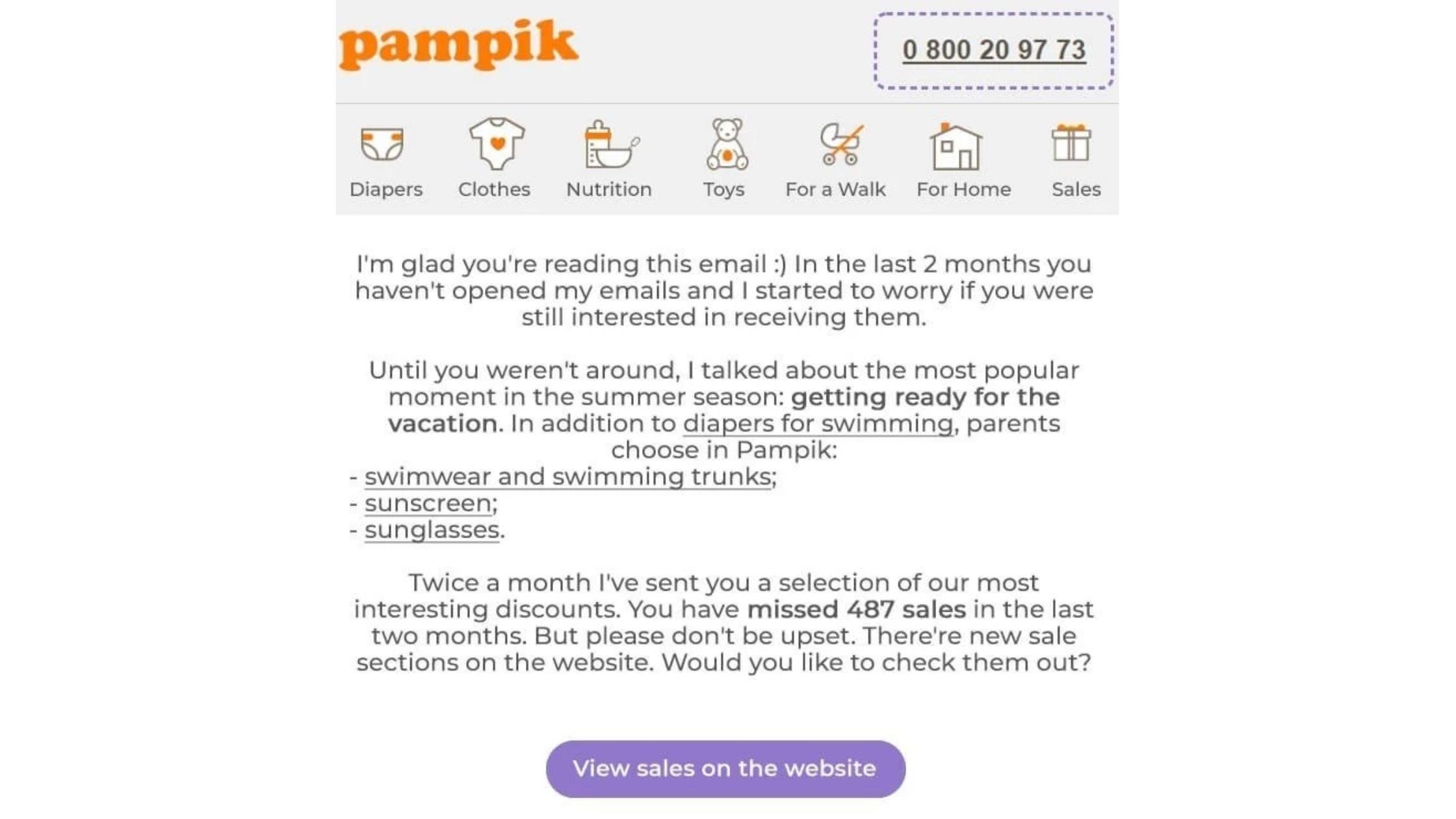
How to Measure the Impact of Your Email Segmentation
It is crucial to track and measure the performance of your segmented campaigns. Thus, to ensure the success of your email segmentation strategy,
You can monitor a range of key metrics, including:
Open Rate:
Track how many subscribers are opening your segmented emails. A higher open rate indicates that your content is resonating.
Click-Through Rate (CTR):
Measure the percentage of subscribers who are clicking on the links within your segmented emails. A higher CTR suggests that your content is compelling and driving action.
Conversion Rate:
Analyze the percentage of subscribers who are taking your desired action, such as making a purchase or signing up for a webinar. This metric directly reflects the effectiveness of your segmented campaigns.
Revenue per Recipient:
Calculate the average revenue generated per subscriber for each of your segmented email campaigns. This will help you identify your most valuable segments and optimize accordingly.
Unsubscribe Rate:
Monitor the number of subscribers who are opting out of your email list after receiving your segmented campaigns. A lower unsubscribe rate indicates that your content is resonating.
Spam Complaint Rate:
Track the number of subscribers who are reporting your segmented emails as spam. This metric can reveal areas where your content or targeting may be missing the mark.
You'll be able to continually refine your segmentation strategies and optimize your email content. This will maximize the return on your email marketing investment.
Conclusion: Segmentation is a Moving Target
Email segmentation isn’t a one-time, hit-or-miss marketing tactic. It's an ongoing process that demands constant testing, analysis, and refining.
You need to continuously monitor the performance of your segmented campaigns. Then you can use these insights to make informed adjustments.
When your subscriber base evolves, and your understanding of their preferences deepens,. You can adapt your segmentation criteria and content strategies accordingly.
Here’s the truth about email marketing in 2024.
The days of sending out one-size-fits-all emails are gone. No matter how flashy your email is or how awesome your copy is, the email isn’t going to cut through the cluttered inbox anymore.
So what’s the secret of getting higher engagement and conversions with email marketing?
The answer is - Segmentation.
In this comprehensive guide, you'll embark on a journey to unlock the secrets of effective email segmentation.
So, let's jump in.
What is Email Segmentation?
Email segmentation is the art of organizing your email subscriber list into smaller, more targeted groups. You can implement segmentation based on various characteristics, behaviors, and preferences.
Instead of sending the same boring message to your entire list, segmentation allows you to tailor your content for micro-audiences.
Why is Email Segmentation so Powerful?
Segmentation allows you to cut through the noise and provide your subscribers with content that is truly relevant and valuable to them.
Let's understand how-
When you implement effective email segmentation, you'll experience a myriad of benefits, including:
1. Increased Open and Click-Through Rates
HubSpot says segmented emails get way more attention than unsegmented ones. You can expect 50% more clickthrough and 30% more open rate in segmented emails.
2. Enhanced Conversion Rates
It is no secret that targeted, personalized messages deeply resonate with your audience. This leads to a significant improvement in engagement and conversions.
3. Improved Customer Retention and Loyalty
With personalized content to segmented audiences, you'll foster stronger relationships which in turn will positively impact customer loyalty.
4. Keeps Your List Healthy
Segmentation reduces the probability of unsubscribes and spam complaints thereby keeping your list healthy.
5. Deeper Insights and Data-Driven Decisions:
Data from segmented campaigns provide invaluable insights allowing you to make more informed, data-driven decisions.
Now that we are clear about the importance of email segmentation, let us dive right into implementation.
How to Incorporate Segmentation in Your Email Marketing
1. Data Collection and Analysis
Segmentation begins with collecting first-party and zero-party customer data and organizing it.
Zero-party data refers to information that your customers willingly and explicitly provide. Such as preferences, interests, and demographic details. This data is incredibly valuable, as it reflects your audience's direct input and intentions.
First-party data, on the other hand, is the information you gather about your subscribers' behaviors and interactions with your brand. This includes website activity, purchase history, and email engagement.
You can combine these two data sources to paint a detailed portrait of your audience. In turn, you can create highly targeted segments that resonate with their unique needs and desires.
2. Segment Definition and Criteria
With a wealth of data at your fingertips, it's time to put it to work by defining your segmentation criteria. This step involves identifying the characteristics, behaviors, and preferences that will serve as the foundation for your targeted email campaigns.
For instance, a buyer has a 27% likelihood of coming back to your shop after making one transaction. You can make this happen if you send a perfectly tailored email segmented for this category.
Some common segmentation criteria to consider include:
- Demographic factors (age, gender, location, etc.)
- Psychographic traits (interests, values, lifestyle)
- Behavioral patterns (website activity, purchase history, email engagement)
- Lifecycle stage (new subscribers, active customers, inactive users)
- Purchase intent and readiness (cart abandoners, product browsing behavior)
- Loyalty and engagement levels (VIPs, frequent buyers, disengaged subscribers)
So, define your segmentation criteria to ensure that each of your email campaigns speaks directly to your target audience.
3. Personalized Content Creation
With your segmented lists in place, it's time to put the power of personalization to work. Craft targeted email content that resonates with each of your distinct subscriber groups. Thus, addressing their pain points, interests, and preferences.
Transaction rates are six times greater when you send personalized emails. Even 90% of marketers say personalization is important.
This level of personalization might include:
- Tailored subject lines and email copy
- Hyper-relevant product recommendations
- Segment-specific offers, discounts, and incentives
- Customized visuals and design elements
- Curated content based on subscribers' interests
Remember, the goal is to make your subscribers feel seen, heard, and valued. This way you'll foster deeper connections, increase engagement, and drive meaningful conversions.
A Few Segmentation Tactics to Consider
Email list segmentation boosts email marketing income by 760% for you. So, let's understand how you can shine in the inbox of your customers.
Combination Segments
Combine multiple segmentation criteria to create highly targeted micro-segments. For example- you could segment by both location and purchase history. This way can deliver unique offers to high-value customers in specific regions.
For example- Nanit sends this email to US people on the 4th of July. They combine location and timing segmentation to create an impact on their customers.

Predictive Segments
Use machine learning and predictive analytics to anticipate your subscribers' behaviors and preferences. This could involve segmenting based on predicted lifetime value, churn risk, or product affinities.
For example- Duolingo sends emails when they analyze that customers are not attending classes and could leave.

Triggered Segments
Leverage real-time data and automation to create dynamic, event-driven segments. You could trigger a tailored campaign for subscribers who abandon their carts. Else you can be more specific like for those who browse specific product categories.
For example- This email by Fabletics men about an abandoned cart.

Persona-Based Segments
Develop detailed buyer personas to guide your segmentation efforts. Group your subscribers according to their unique pain points, motivations, and shopping habits. Then craft content that resonates with each persona.
For Example- Rael does it by constantly reviewing when customers check their products. Sending them emails to remind the same products.

You can use tools like Klaviyo to incorporate advanced tactics. They can work wonders for your business when used strategically.
Behavior-based Segments
This segment groups email recipients based on their actions or interactions with your brand. You can segment customers by the products they've purchased or pages they visited.
Audible sends this email to the customer, stating that their wish list is now available.

Demographic Segments
Demographic segment groups such as age, income location, etc. This segment gathers all the demographic information of its users and craft emails accordingly.
For Example- You can see Groupon uses location details to send this email to customers based in California.

Life cycle Segments
This is one of the most crucial segments. Here, you can group the customers on their stage in the customer journey. It includes new subscribers, active customers, and, lapsing ones.
Squarespace sends this kind of email to new customers.

Gender-based Segments
This segment groups recipients based on their gender. While personalization is key, avoid stereotypes here. Focus on product offerings or content that might be relevant to different genders.
Here are two different emails from prom.ua. This one is for women’s shoes.

This one is for men’s shoes.

Customer Activity Segments
This is a broad category that can overlap with some of the others. Event registrations, survey responders, and cart abandoners are counted under this segmentation.
For example, Pampik attracts customers who become highly inactive to remind them about what’s new.

How to Measure the Impact of Your Email Segmentation
It is crucial to track and measure the performance of your segmented campaigns. Thus, to ensure the success of your email segmentation strategy,
You can monitor a range of key metrics, including:
Open Rate:
Track how many subscribers are opening your segmented emails. A higher open rate indicates that your content is resonating.
Click-Through Rate (CTR):
Measure the percentage of subscribers who are clicking on the links within your segmented emails. A higher CTR suggests that your content is compelling and driving action.
Conversion Rate:
Analyze the percentage of subscribers who are taking your desired action, such as making a purchase or signing up for a webinar. This metric directly reflects the effectiveness of your segmented campaigns.
Revenue per Recipient:
Calculate the average revenue generated per subscriber for each of your segmented email campaigns. This will help you identify your most valuable segments and optimize accordingly.
Unsubscribe Rate:
Monitor the number of subscribers who are opting out of your email list after receiving your segmented campaigns. A lower unsubscribe rate indicates that your content is resonating.
Spam Complaint Rate:
Track the number of subscribers who are reporting your segmented emails as spam. This metric can reveal areas where your content or targeting may be missing the mark.
You'll be able to continually refine your segmentation strategies and optimize your email content. This will maximize the return on your email marketing investment.
Conclusion: Segmentation is a Moving Target
Email segmentation isn’t a one-time, hit-or-miss marketing tactic. It's an ongoing process that demands constant testing, analysis, and refining.
You need to continuously monitor the performance of your segmented campaigns. Then you can use these insights to make informed adjustments.
When your subscriber base evolves, and your understanding of their preferences deepens,. You can adapt your segmentation criteria and content strategies accordingly.
Here’s the truth about email marketing in 2024.
The days of sending out one-size-fits-all emails are gone. No matter how flashy your email is or how awesome your copy is, the email isn’t going to cut through the cluttered inbox anymore.
So what’s the secret of getting higher engagement and conversions with email marketing?
The answer is - Segmentation.
In this comprehensive guide, you'll embark on a journey to unlock the secrets of effective email segmentation.
So, let's jump in.
What is Email Segmentation?
Email segmentation is the art of organizing your email subscriber list into smaller, more targeted groups. You can implement segmentation based on various characteristics, behaviors, and preferences.
Instead of sending the same boring message to your entire list, segmentation allows you to tailor your content for micro-audiences.
Why is Email Segmentation so Powerful?
Segmentation allows you to cut through the noise and provide your subscribers with content that is truly relevant and valuable to them.
Let's understand how-
When you implement effective email segmentation, you'll experience a myriad of benefits, including:
1. Increased Open and Click-Through Rates
HubSpot says segmented emails get way more attention than unsegmented ones. You can expect 50% more clickthrough and 30% more open rate in segmented emails.
2. Enhanced Conversion Rates
It is no secret that targeted, personalized messages deeply resonate with your audience. This leads to a significant improvement in engagement and conversions.
3. Improved Customer Retention and Loyalty
With personalized content to segmented audiences, you'll foster stronger relationships which in turn will positively impact customer loyalty.
4. Keeps Your List Healthy
Segmentation reduces the probability of unsubscribes and spam complaints thereby keeping your list healthy.
5. Deeper Insights and Data-Driven Decisions:
Data from segmented campaigns provide invaluable insights allowing you to make more informed, data-driven decisions.
Now that we are clear about the importance of email segmentation, let us dive right into implementation.
How to Incorporate Segmentation in Your Email Marketing
1. Data Collection and Analysis
Segmentation begins with collecting first-party and zero-party customer data and organizing it.
Zero-party data refers to information that your customers willingly and explicitly provide. Such as preferences, interests, and demographic details. This data is incredibly valuable, as it reflects your audience's direct input and intentions.
First-party data, on the other hand, is the information you gather about your subscribers' behaviors and interactions with your brand. This includes website activity, purchase history, and email engagement.
You can combine these two data sources to paint a detailed portrait of your audience. In turn, you can create highly targeted segments that resonate with their unique needs and desires.
2. Segment Definition and Criteria
With a wealth of data at your fingertips, it's time to put it to work by defining your segmentation criteria. This step involves identifying the characteristics, behaviors, and preferences that will serve as the foundation for your targeted email campaigns.
For instance, a buyer has a 27% likelihood of coming back to your shop after making one transaction. You can make this happen if you send a perfectly tailored email segmented for this category.
Some common segmentation criteria to consider include:
- Demographic factors (age, gender, location, etc.)
- Psychographic traits (interests, values, lifestyle)
- Behavioral patterns (website activity, purchase history, email engagement)
- Lifecycle stage (new subscribers, active customers, inactive users)
- Purchase intent and readiness (cart abandoners, product browsing behavior)
- Loyalty and engagement levels (VIPs, frequent buyers, disengaged subscribers)
So, define your segmentation criteria to ensure that each of your email campaigns speaks directly to your target audience.
3. Personalized Content Creation
With your segmented lists in place, it's time to put the power of personalization to work. Craft targeted email content that resonates with each of your distinct subscriber groups. Thus, addressing their pain points, interests, and preferences.
Transaction rates are six times greater when you send personalized emails. Even 90% of marketers say personalization is important.
This level of personalization might include:
- Tailored subject lines and email copy
- Hyper-relevant product recommendations
- Segment-specific offers, discounts, and incentives
- Customized visuals and design elements
- Curated content based on subscribers' interests
Remember, the goal is to make your subscribers feel seen, heard, and valued. This way you'll foster deeper connections, increase engagement, and drive meaningful conversions.
A Few Segmentation Tactics to Consider
Email list segmentation boosts email marketing income by 760% for you. So, let's understand how you can shine in the inbox of your customers.
Combination Segments
Combine multiple segmentation criteria to create highly targeted micro-segments. For example- you could segment by both location and purchase history. This way can deliver unique offers to high-value customers in specific regions.
For example- Nanit sends this email to US people on the 4th of July. They combine location and timing segmentation to create an impact on their customers.

Predictive Segments
Use machine learning and predictive analytics to anticipate your subscribers' behaviors and preferences. This could involve segmenting based on predicted lifetime value, churn risk, or product affinities.
For example- Duolingo sends emails when they analyze that customers are not attending classes and could leave.

Triggered Segments
Leverage real-time data and automation to create dynamic, event-driven segments. You could trigger a tailored campaign for subscribers who abandon their carts. Else you can be more specific like for those who browse specific product categories.
For example- This email by Fabletics men about an abandoned cart.

Persona-Based Segments
Develop detailed buyer personas to guide your segmentation efforts. Group your subscribers according to their unique pain points, motivations, and shopping habits. Then craft content that resonates with each persona.
For Example- Rael does it by constantly reviewing when customers check their products. Sending them emails to remind the same products.

You can use tools like Klaviyo to incorporate advanced tactics. They can work wonders for your business when used strategically.
Behavior-based Segments
This segment groups email recipients based on their actions or interactions with your brand. You can segment customers by the products they've purchased or pages they visited.
Audible sends this email to the customer, stating that their wish list is now available.

Demographic Segments
Demographic segment groups such as age, income location, etc. This segment gathers all the demographic information of its users and craft emails accordingly.
For Example- You can see Groupon uses location details to send this email to customers based in California.

Life cycle Segments
This is one of the most crucial segments. Here, you can group the customers on their stage in the customer journey. It includes new subscribers, active customers, and, lapsing ones.
Squarespace sends this kind of email to new customers.

Gender-based Segments
This segment groups recipients based on their gender. While personalization is key, avoid stereotypes here. Focus on product offerings or content that might be relevant to different genders.
Here are two different emails from prom.ua. This one is for women’s shoes.

This one is for men’s shoes.

Customer Activity Segments
This is a broad category that can overlap with some of the others. Event registrations, survey responders, and cart abandoners are counted under this segmentation.
For example, Pampik attracts customers who become highly inactive to remind them about what’s new.

How to Measure the Impact of Your Email Segmentation
It is crucial to track and measure the performance of your segmented campaigns. Thus, to ensure the success of your email segmentation strategy,
You can monitor a range of key metrics, including:
Open Rate:
Track how many subscribers are opening your segmented emails. A higher open rate indicates that your content is resonating.
Click-Through Rate (CTR):
Measure the percentage of subscribers who are clicking on the links within your segmented emails. A higher CTR suggests that your content is compelling and driving action.
Conversion Rate:
Analyze the percentage of subscribers who are taking your desired action, such as making a purchase or signing up for a webinar. This metric directly reflects the effectiveness of your segmented campaigns.
Revenue per Recipient:
Calculate the average revenue generated per subscriber for each of your segmented email campaigns. This will help you identify your most valuable segments and optimize accordingly.
Unsubscribe Rate:
Monitor the number of subscribers who are opting out of your email list after receiving your segmented campaigns. A lower unsubscribe rate indicates that your content is resonating.
Spam Complaint Rate:
Track the number of subscribers who are reporting your segmented emails as spam. This metric can reveal areas where your content or targeting may be missing the mark.
You'll be able to continually refine your segmentation strategies and optimize your email content. This will maximize the return on your email marketing investment.
Conclusion: Segmentation is a Moving Target
Email segmentation isn’t a one-time, hit-or-miss marketing tactic. It's an ongoing process that demands constant testing, analysis, and refining.
You need to continuously monitor the performance of your segmented campaigns. Then you can use these insights to make informed adjustments.
When your subscriber base evolves, and your understanding of their preferences deepens,. You can adapt your segmentation criteria and content strategies accordingly.
Here’s the truth about email marketing in 2024.
The days of sending out one-size-fits-all emails are gone. No matter how flashy your email is or how awesome your copy is, the email isn’t going to cut through the cluttered inbox anymore.
So what’s the secret of getting higher engagement and conversions with email marketing?
The answer is - Segmentation.
In this comprehensive guide, you'll embark on a journey to unlock the secrets of effective email segmentation.
So, let's jump in.
What is Email Segmentation?
Email segmentation is the art of organizing your email subscriber list into smaller, more targeted groups. You can implement segmentation based on various characteristics, behaviors, and preferences.
Instead of sending the same boring message to your entire list, segmentation allows you to tailor your content for micro-audiences.
Why is Email Segmentation so Powerful?
Segmentation allows you to cut through the noise and provide your subscribers with content that is truly relevant and valuable to them.
Let's understand how-
When you implement effective email segmentation, you'll experience a myriad of benefits, including:
1. Increased Open and Click-Through Rates
HubSpot says segmented emails get way more attention than unsegmented ones. You can expect 50% more clickthrough and 30% more open rate in segmented emails.
2. Enhanced Conversion Rates
It is no secret that targeted, personalized messages deeply resonate with your audience. This leads to a significant improvement in engagement and conversions.
3. Improved Customer Retention and Loyalty
With personalized content to segmented audiences, you'll foster stronger relationships which in turn will positively impact customer loyalty.
4. Keeps Your List Healthy
Segmentation reduces the probability of unsubscribes and spam complaints thereby keeping your list healthy.
5. Deeper Insights and Data-Driven Decisions:
Data from segmented campaigns provide invaluable insights allowing you to make more informed, data-driven decisions.
Now that we are clear about the importance of email segmentation, let us dive right into implementation.
How to Incorporate Segmentation in Your Email Marketing
1. Data Collection and Analysis
Segmentation begins with collecting first-party and zero-party customer data and organizing it.
Zero-party data refers to information that your customers willingly and explicitly provide. Such as preferences, interests, and demographic details. This data is incredibly valuable, as it reflects your audience's direct input and intentions.
First-party data, on the other hand, is the information you gather about your subscribers' behaviors and interactions with your brand. This includes website activity, purchase history, and email engagement.
You can combine these two data sources to paint a detailed portrait of your audience. In turn, you can create highly targeted segments that resonate with their unique needs and desires.
2. Segment Definition and Criteria
With a wealth of data at your fingertips, it's time to put it to work by defining your segmentation criteria. This step involves identifying the characteristics, behaviors, and preferences that will serve as the foundation for your targeted email campaigns.
For instance, a buyer has a 27% likelihood of coming back to your shop after making one transaction. You can make this happen if you send a perfectly tailored email segmented for this category.
Some common segmentation criteria to consider include:
- Demographic factors (age, gender, location, etc.)
- Psychographic traits (interests, values, lifestyle)
- Behavioral patterns (website activity, purchase history, email engagement)
- Lifecycle stage (new subscribers, active customers, inactive users)
- Purchase intent and readiness (cart abandoners, product browsing behavior)
- Loyalty and engagement levels (VIPs, frequent buyers, disengaged subscribers)
So, define your segmentation criteria to ensure that each of your email campaigns speaks directly to your target audience.
3. Personalized Content Creation
With your segmented lists in place, it's time to put the power of personalization to work. Craft targeted email content that resonates with each of your distinct subscriber groups. Thus, addressing their pain points, interests, and preferences.
Transaction rates are six times greater when you send personalized emails. Even 90% of marketers say personalization is important.
This level of personalization might include:
- Tailored subject lines and email copy
- Hyper-relevant product recommendations
- Segment-specific offers, discounts, and incentives
- Customized visuals and design elements
- Curated content based on subscribers' interests
Remember, the goal is to make your subscribers feel seen, heard, and valued. This way you'll foster deeper connections, increase engagement, and drive meaningful conversions.
A Few Segmentation Tactics to Consider
Email list segmentation boosts email marketing income by 760% for you. So, let's understand how you can shine in the inbox of your customers.
Combination Segments
Combine multiple segmentation criteria to create highly targeted micro-segments. For example- you could segment by both location and purchase history. This way can deliver unique offers to high-value customers in specific regions.
For example- Nanit sends this email to US people on the 4th of July. They combine location and timing segmentation to create an impact on their customers.

Predictive Segments
Use machine learning and predictive analytics to anticipate your subscribers' behaviors and preferences. This could involve segmenting based on predicted lifetime value, churn risk, or product affinities.
For example- Duolingo sends emails when they analyze that customers are not attending classes and could leave.

Triggered Segments
Leverage real-time data and automation to create dynamic, event-driven segments. You could trigger a tailored campaign for subscribers who abandon their carts. Else you can be more specific like for those who browse specific product categories.
For example- This email by Fabletics men about an abandoned cart.

Persona-Based Segments
Develop detailed buyer personas to guide your segmentation efforts. Group your subscribers according to their unique pain points, motivations, and shopping habits. Then craft content that resonates with each persona.
For Example- Rael does it by constantly reviewing when customers check their products. Sending them emails to remind the same products.

You can use tools like Klaviyo to incorporate advanced tactics. They can work wonders for your business when used strategically.
Behavior-based Segments
This segment groups email recipients based on their actions or interactions with your brand. You can segment customers by the products they've purchased or pages they visited.
Audible sends this email to the customer, stating that their wish list is now available.

Demographic Segments
Demographic segment groups such as age, income location, etc. This segment gathers all the demographic information of its users and craft emails accordingly.
For Example- You can see Groupon uses location details to send this email to customers based in California.

Life cycle Segments
This is one of the most crucial segments. Here, you can group the customers on their stage in the customer journey. It includes new subscribers, active customers, and, lapsing ones.
Squarespace sends this kind of email to new customers.

Gender-based Segments
This segment groups recipients based on their gender. While personalization is key, avoid stereotypes here. Focus on product offerings or content that might be relevant to different genders.
Here are two different emails from prom.ua. This one is for women’s shoes.

This one is for men’s shoes.

Customer Activity Segments
This is a broad category that can overlap with some of the others. Event registrations, survey responders, and cart abandoners are counted under this segmentation.
For example, Pampik attracts customers who become highly inactive to remind them about what’s new.

How to Measure the Impact of Your Email Segmentation
It is crucial to track and measure the performance of your segmented campaigns. Thus, to ensure the success of your email segmentation strategy,
You can monitor a range of key metrics, including:
Open Rate:
Track how many subscribers are opening your segmented emails. A higher open rate indicates that your content is resonating.
Click-Through Rate (CTR):
Measure the percentage of subscribers who are clicking on the links within your segmented emails. A higher CTR suggests that your content is compelling and driving action.
Conversion Rate:
Analyze the percentage of subscribers who are taking your desired action, such as making a purchase or signing up for a webinar. This metric directly reflects the effectiveness of your segmented campaigns.
Revenue per Recipient:
Calculate the average revenue generated per subscriber for each of your segmented email campaigns. This will help you identify your most valuable segments and optimize accordingly.
Unsubscribe Rate:
Monitor the number of subscribers who are opting out of your email list after receiving your segmented campaigns. A lower unsubscribe rate indicates that your content is resonating.
Spam Complaint Rate:
Track the number of subscribers who are reporting your segmented emails as spam. This metric can reveal areas where your content or targeting may be missing the mark.
You'll be able to continually refine your segmentation strategies and optimize your email content. This will maximize the return on your email marketing investment.
Conclusion: Segmentation is a Moving Target
Email segmentation isn’t a one-time, hit-or-miss marketing tactic. It's an ongoing process that demands constant testing, analysis, and refining.
You need to continuously monitor the performance of your segmented campaigns. Then you can use these insights to make informed adjustments.
When your subscriber base evolves, and your understanding of their preferences deepens,. You can adapt your segmentation criteria and content strategies accordingly.
More to Explore
More to Explore
Ready to find out how we can help you achieve 20-30% revenue growth with email marketing?
Ready to find out how we can help you achieve 20-30% revenue growth with email marketing?
Ready to find out how we can help you achieve 20-30% revenue growth with email marketing?
12th floor, Shivarth The Ace, Karma Workspaces, Sindhubhavan Rd, Ahmedabad, Gujarat 380054
2727 Bee Cave Rd, Suite 180, Austin, TX 78746

support@copypowermedia.com
12th floor, Shivarth The Ace, Karma Workspaces, Sindhubhavan Rd, Ahmedabad, Gujarat 380054
2727 Bee Cave Rd, Suite 180, Austin, TX 78746

support@copypowermedia.com
12th floor, Shivarth The Ace, Karma Workspaces, Sindhubhavan Rd, Ahmedabad, Gujarat 380054
2727 Bee Cave Rd, Suite 180, Austin, TX 78746

support@copypowermedia.com




